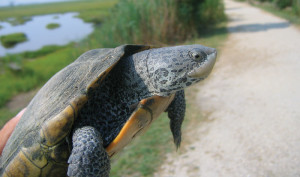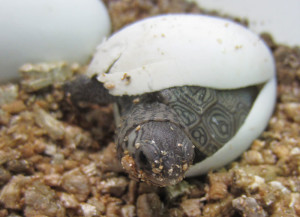by Brian Williamson
 If you spend time at the shore, you probably are familiar with diamondback terrapins. They are our local saltmarsh turtle; unique in that they are the only reptiles that thrive in this habitat. They are most often seen when the females come out of the marshes to nest from May until July. You also may have seen their heads as you kayak through local creeks. Perhaps you have seen the quarter-sized hatchlings, which emerge from their nests in the fall and spring.
If you spend time at the shore, you probably are familiar with diamondback terrapins. They are our local saltmarsh turtle; unique in that they are the only reptiles that thrive in this habitat. They are most often seen when the females come out of the marshes to nest from May until July. You also may have seen their heads as you kayak through local creeks. Perhaps you have seen the quarter-sized hatchlings, which emerge from their nests in the fall and spring.
Yet terrapins are in trouble throughout their range. They face the effects of habitat loss due to human development and climate change. Although males rarely leave the water, nesting females often must cross roads to nest and hundreds are killed each summer. Untold numbers are caught as bycatch in crab traps and drown each year. Nest and hatchling predators, such as raccoons and skunks, are now more abundant due to the feast our garbage provides. This overabundance of predators reduces the number of hatchlings that survive to maturity. All of these threats combine to make the future of terrapins uncertain.
The Wetlands Institute has worked diligently for over 25 years to make sure terrapins remain a vital part of our local coastal ecosystem. Started by Dr. Roger Wood in conjunction with Stockton University, our terrapin research and conservation program works to increase our understanding of terrapins and develop ways to protect them from the threats they face.
In 1991 we began patrols of local roadways to document impacts of vehicles on terrapin populations. Each year, from May through July, we patrol 38 miles of roads from Stone Harbor to Sea Isle City. Data collected on patrols have revealed the scale of the threat roads pose to terrapins – nearly 500 female terrapins are killed each year on these roads.
 While this is a sobering statistic, our patrols allow us to reduce impacts from roads. Many terrapins killed on roads still hold viable eggs. We retrieve these eggs and incubate them in our lab. Incubation temperature determines sex for terrapins; therefore, we adjust incubator temperatures to produce female hatchlings and help offset the loss of their deceased mothers. With the help of Stockton University and trained school teachers, we raise these hatchlings for one year, keeping them active and fed year-round. This process, called headstarting, allows terrapins to reach a size up to three times that of a wild turtle the same age, and leaves them less vulnerable to predators. Over the years, we have released 2,250 headstarted terrapins to local marshes. Each year we also treat injuries and save hundreds of terrapins crossing roads, and work with partners to limit the number of terrapins crossing roads.
While this is a sobering statistic, our patrols allow us to reduce impacts from roads. Many terrapins killed on roads still hold viable eggs. We retrieve these eggs and incubate them in our lab. Incubation temperature determines sex for terrapins; therefore, we adjust incubator temperatures to produce female hatchlings and help offset the loss of their deceased mothers. With the help of Stockton University and trained school teachers, we raise these hatchlings for one year, keeping them active and fed year-round. This process, called headstarting, allows terrapins to reach a size up to three times that of a wild turtle the same age, and leaves them less vulnerable to predators. Over the years, we have released 2,250 headstarted terrapins to local marshes. Each year we also treat injuries and save hundreds of terrapins crossing roads, and work with partners to limit the number of terrapins crossing roads.
Since 1997 we have been conducting a long-term population study of terrapins in our local marshes. Each year, we capture terrapins and mark them with uniquely coded microchips that let us identify individuals. To date, we have marked nearly 5,000 terrapins. By marking, releasing, and recapturing turtles over many years, we can derive population size, survival rates, growth, movements, and individual nesting habitat preferences to help us better understand and protect them.
We also protect terrapin nests with predator exclosures, distribute Bycatch Reduction Devices to keep terrapins out of crab pots, work with volunteers to rescue terrapin hatchlings from storm drains, mentor interns each summer who help conduct research projects on terrapins, and engage the public in terrapin conservation. Over the past 25 years The Wetlands Institute has become a leader in diamondback terrapin research and conservation. We remain committed to monitoring and protecting terrapin populations near and far, and look forward to continuing our legacy of terrapin conservation into the future.
